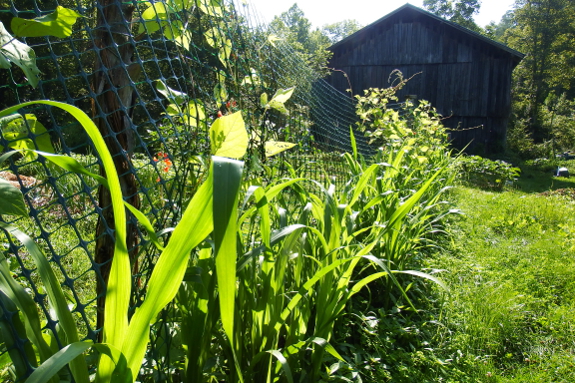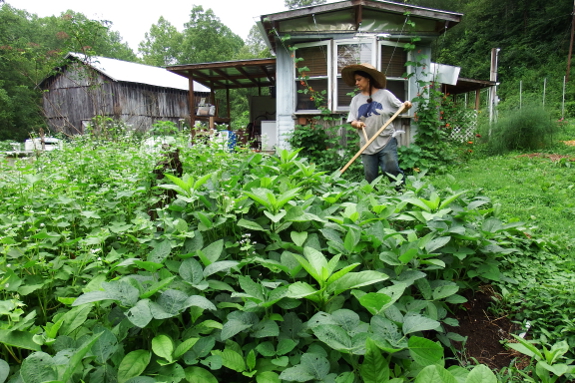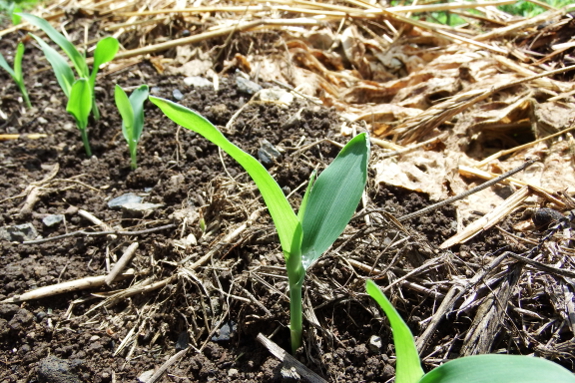
Cut-and-come-again cover-crop experiments

You may recall that I planted some experimental cover crops this year hoping they'd be cut-and-come-again mulch producers.
The ones I was most excited about --- pearl millet and
sorghum-sudangrass hybrids --- aren't really living up to their
potential. These warm-season grasses remind me of corn in that they grow
big stalks that require interim weeding and mulching, but the cover
crop versions actually appear to produce less biomass than corn does. As
a result, I feel like I would have been better off planting these beds
with sweet corn or field corn then using the corn stalks if I wanted to
harvest biomass from warm-season grasses. All told, I'm not very
impressed by the warm-season grasses, even though sorghum-sudangrass
hybrids are reputed to produce more biomass per acre than any other
cover crop.

On the other hand, soybeans as a cover crop
continue to intrigue me. The soybeans we planted on June 10 are just
starting to bloom, so I chose one patch to scythe a few inches above the
ground in hopes the plants will grow back and let me cut again in a few
more weeks. While I was at it, I also scythed the buckwheat growing
next door (planted two weeks later) and then I replanted the whole patch
with new buckwheat seeds.
Before I go into the
results, I should tell you that I'd been out cutting pasture weeds
before embarking on this experiment, so my scythe was a little dull. As a
result, the tool yanked up (rather than cut down) perhaps 10% of the
soybeans. Gathering up the cut tops was easy, but I only got an armload
out of this whole patch, which would probably be about enough to mulch
15 square feet in the garden. Lazily, I instead simply tossed the cut
tops onto our compost pile.

A perhaps better use of a
soybean cover crop (although more expensive since the initial seed
investment doesn't go as far) is to pull up entire soybean plants then
use the legumes to feed the next crop. I yanked up the soybean plants in
the bed pictured above less than a week ago, piling the cover crops in
between rows of new sweet corn. The soybeans are so high in nitrogen
that they're already disintegrating into the soil six days later,
meaning they'll feed the corn plants by the time the roots reach the
center of the bed. Whether or not the soybeans produce enough nitrogen
to feed an entire bed of corn with no additional amendment remains to be
seen. I'll keep an eye on leaf color and report back in a few more
weeks.
Want more in-depth information? Browse through our books.
Or explore more posts by date or by subject.
About us: Anna Hess and Mark Hamilton spent over a decade living self-sufficiently in the mountains of Virginia before moving north to start over from scratch in the foothills of Ohio. They've experimented with permaculture, no-till gardening, trailersteading, home-based microbusinesses and much more, writing about their adventures in both blogs and books.
Want to be notified when new comments are posted on this page? Click on the RSS button after you add a comment to subscribe to the comment feed, or simply check the box beside "email replies to me" while writing your comment.

I've had luck with broadcasting southern peas during the rainy summer. They can take the heat and seem to fix a lot of nitrogen.
I've also been messing around with really complicated mixes of every kind of seed I can find - photo evidence here: http://www.floridasurvivalgardening.com/2015/04/want-fast-food-forest-try-this.html
Some things really pop, some don't. The asjwain has been impressive, as has the sorghum. The castor beans barely managed to pop up a few plants here and there. Keep experimenting!
Hi Anna,
We have been growing soy for years now as edamame, to eat. I'm curious why you do not grow the soy until the pods are edible. Does it take too long? Are the plants not as effective at adding nitrogen once they fruit? I'm new to cover crops so please excuse me if my questions seem dumb. I was just surprised tha you did not mention harvesting before you cut down the plants- edamame is so delicious, and a great source of protein, excellent both lightly steamed with a little salt, or frozen and then mixed into winter soups. Thank you!
Grant
Hi Anna I have been reading your blog for some time now and have learned so much. Soybeans as a cover crop fascinate me. Where do you find your seed? I'm curious about experimenting with them as a cover crop/ green manure. My "Ranchette' is in zone 9B. I live SW of Houston very near the Gulf of Mexico. I frequently see them as row crops grown commercially here. I am a fellow experimenter and would like to grow them. I enjoy eating them also. I find most legumes grow fantastic here- just poke em in the ground and let the South Texas heat and humidity do its thing. So I look forward to finding a good organic source. Are they heirloom? Thanks - Susie Q